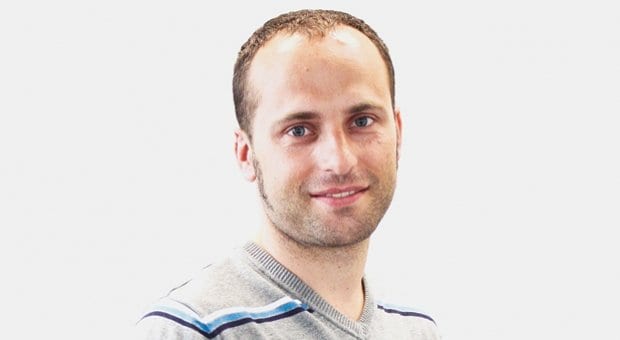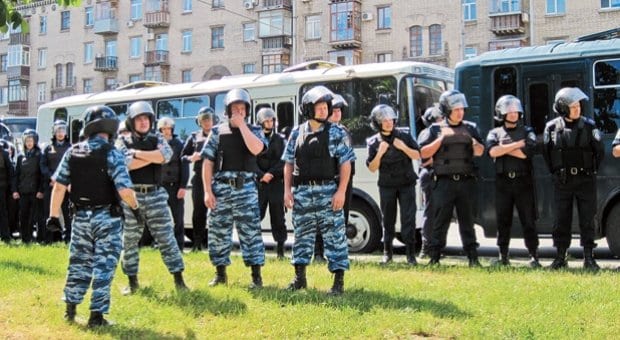
Anti-gay protesters attacked human rights demonstrators on May 17 in Tbilisi, Georgia.

Boris Balanetkii, ILGA-Europe.
Go ahead: take part in this year’s Toronto Pride parade, but there’s probably no way you’ll feel as frightened, or as proud, as Olena Semenova did at the Pride march last month in Ukraine.
Semenova, a 35-year-old lesbian who makes sports equipment for a living, helped organize the first Pride march ever to be held in her hometown of Kiev. To do it, she stared into the face of danger. Last year, the first attempt at a march was cancelled at the last minute when hundreds of angry protesters turned out and police refused to protect the 100 or so Pride participants. Protesters beat up two of Semenova’s comrades in broad daylight. A month later, another Pride organizer was chased and attacked for trying to organize the aborted march.
This year, Kiev’s march almost didn’t make it past the planning stage. A court order blocked the organizers from their first route, but Semenova and her allies couldn’t be stopped. They moved the march a few kilometres away, to a 500-metre alley. There, they were joined by representatives from Kiev’s sister city, Munich, including its deputy mayor, as well as Amnesty International. “They saw with their own eyes how endangered we were,” Semenova says of her group’s supporters. “They were really brave to be with us.” Like last year, about 100 people showed up for the march, as well as more than 1,000 protesters shouting, “You will be punished by God” and “Gay shame, leave Ukraine.” But this time, the police came, too.
“Until the last moment, we were wondering if the police would really protect us,” Semenova says. They did, and everyone finished the short march safely. “It was an unbelievable feeling,” Semenova says, “a feeling of great victory, because it was the very first gay protest march in Ukrainian history. It was an important and exciting moment, and everyone in the crowd felt it.”
For queer activists in Ukraine and the other 14 countries that used to be part of the former Soviet Union, this spring has been a time of setbacks and success. About 50 people in Chisinau, Moldova, safely pulled off their first Pride march, too, but in the Georgian capital of Tbilisi (just over the border from Sochi, Russia, where next year’s Winter Olympics are taking place), a huge tragedy was barely averted. There, two dozen human rights demonstrators, mostly women, were attacked on May 17, the International Day Against Homophobia, when they held up pro-gay signs in a central square. Angry protesters led by priests from the Georgian Orthodox Church spat in their faces and hurled bottles at them.
Even after police hustled the Georgian human rights demonstrators into a yellow minivan, the mob didn’t stop. In fact, it surged in strength until it numbered in the thousands. This is how the scene is described by demonstrator Mariam Gagoshashvili on the website of Identoba (Identity), a Georgian human rights NGO: “The counter-protesters attacked us from outside, broke windows, tried to drag us out, threw stones, bit us, grabbed our hair and bodies, threw bottles, spit at us and swore. The crowd gathered against us was more than ready to tear us apart and kill us.”
Gagoshashvili adds, “Needless to say, everyone is shocked and psychologically devastated.” Since that day, Identoba has counted dozens of other violent incidents against queer people in Georgia.
In Russia, the recent setbacks to the gay-rights cause are a little better known. There, Parliament passed a law against so-called gay propaganda by an absurdly lopsided vote of 434 to zero (with one lonely abstention). Brave demonstrators in Moscow staged a kiss-in to protest the law’s passage. Meanwhile, other former Soviet states, including those known as the Stans (Tajikistan, Uzbekistan, Kyrgyzstan and others), are still years away from having any public gay-rights presence. Homosexuality is legal in most of the region, but it’s far from being socially accepted.
What is it about Russia and its surrounding countries that makes the region so homophobic, and what can be done about it? When asked the first part of the question, Identoba leader Irakli Vacharadze laughs at how long the list is: “The Soviet totalitarian past when homosexuals were criminalized… cultural isolation during Soviet times… invisibility of LGBT communities… homophobic politicians…” The list goes on.
Semenova adds two other key causes of homophobia. First, she says, governments in the region use gays as scapegoats, blaming them for bad economic times or, at the very least, trying to distract voters by debating ineffectual laws against gay propaganda (Ukraine’s Russian-style legislation is still to be voted on). Secondly, people in her home and neighbouring countries “don’t understand what human rights are about, what they include or who they’re for. They don’t understand what we want.”
But the main influence of homophobia in the region is the usual one — religion. Boris Balanetkii, who monitors the former Soviet states for ILGA-Europe (the International Lesbian, Gay, Bisexual, Trans and Intersex Association) says the powerful Orthodox Church is somewhat different in every country but essentially follows the same stream. “They promote homophobia to reach their goals, and they ally themselves with far-right politicians and neo-Nazi organizations,” says Balanetkii, who is originally from Moldova but now works for ILGA-Europe in Brussels. “In order to achieve its goals, the church is ready to make alliances with organizations they’re supposed to condemn.”
Vacharadze adds that, in the Soviet era, the KGB controlled the church, and today its ties to government agencies remain strong. “Priests get rich and influential,” Vacharadze says, “and invent gay internal enemies.”
Balanetkii sees hope in the fact that European funding agencies are successfully pressuring many of the countries he monitors to respect gay rights. Moldova, for instance, has rejected almost all the bills against gay propaganda introduced there. But, Balanetkii adds, “Ukraine is torn in two directions,” between Russia and Europe, and Russia is so powerful on its own that it can’t be influenced by anyone else. “They don’t need alliances,” Balanetkii says, “so it’s very difficult to influence the human rights situation there.” That could soon change, though, if Russia continues to face criticism from human rights organizations ahead of next year’s Winter Olympics.
In the meantime, Vacharadze says gay people in his country and others continue to meet in a few gay-friendly cafés and party at private homes, all the while plotting the next show of public gay pride. It’s not easy, though. “We’re all concerned about our safety,” Semenova says, especially because the region’s few leading gay-rights activists have their names and faces prominently featured in social media. “We’re really, really careful about where we go,” she says.
But Semenova is shockingly nonchalant about the risks. “It’s dangerous, but it’s life,” she says. And, as proven by the incredible feeling she had after this year’s Pride march in Kiev, the personal rewards can be great. “I love being an activist,” she says. “I’m motivated by a human-rights hunger.”

 Why you can trust Xtra
Why you can trust Xtra


